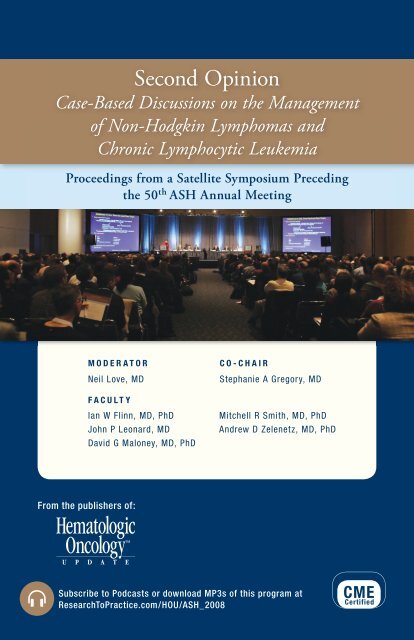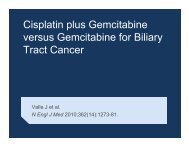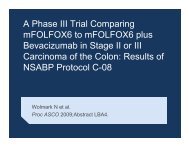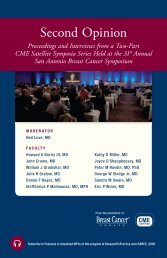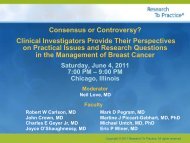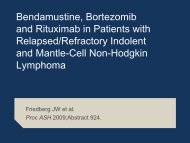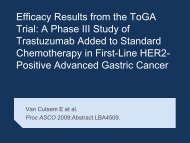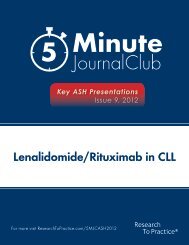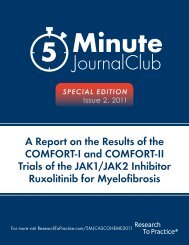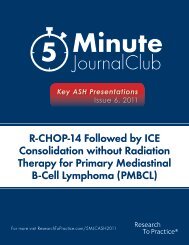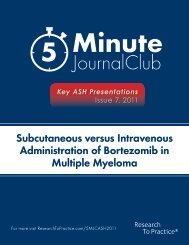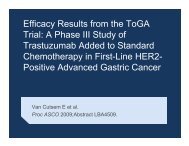Second Opinion
Download - Research To Practice
Download - Research To Practice
- No tags were found...
Create successful ePaper yourself
Turn your PDF publications into a flip-book with our unique Google optimized e-Paper software.
<strong>Second</strong> <strong>Opinion</strong>Case-Based Discussions on the Managementof Non-Hodgkin Lymphomas andChronic Lymphocytic LeukemiaProceedings from a Satellite Symposium Precedingthe 50 th ASH Annual MeetingM O D E R A T O RNeil Love, MDF A C U L T YIan W Flinn, MD, PhDJohn P Leonard, MDDavid G Maloney, MD, PhDC O - C H A I RStephanie A Gregory, MDMitchell R Smith, MD, PhDAndrew D Zelenetz, MD, PhDFrom the publishers of:Subscribe to Podcasts or download MP3s of this program atResearchToPractice.com/HOU/ASH_2008CMECertified
<strong>Second</strong> <strong>Opinion</strong>:A Continuing Medical Education ProgramO V E R V I E W O F A C T I V I T YNon-Hodgkin lymphomas (NHL) constitute a heterogeneous group of lymphoproliferative disorders. NHL is an area of activeresearch and represents a rapidly evolving field in medical oncology. Published results from ongoing clinical trials lead to thecontinual emergence of new therapeutic agents and strategies. To bridge the gap between research and patient care, theseproceedings from a case-based CME satellite symposium at the 2008 American Society of Hematology Annual Meetingutilize the perspectives of clinical investigators, in addition to the interactive exchange between these individuals, to applyevidence-based concepts to routine clinical care. By providing access to the latest research developments and expertopinions on the disease, this activity will assist medical oncologists, hematologists and hematology-oncology fellows in theformulation of up-to-date clinical management strategies for NHL and chronic lymphocytic leukemia (CLL).L E A R N I N G O B J E C T I V E S• Recount the natural history of CLL, and assess the rational indications for initiation of medical intervention withcytotoxics, monoclonal antibodies and immunomodulatory agents.• Develop a treatment algorithm to optimize clinical outcomes and quality of life for patients with newly diagnosed orrelapsed/refractory follicular lymphoma.• Identify tolerable and efficacious systemic regimens for patients with diffuse large B-cell lymphoma (DLBCL) andadvanced age or preexisting comorbidities.• Discuss treatment options, including standard or intensive induction therapy and autologous stem cell transplant, withpatients who have newly diagnosed mantle-cell lymphoma.• Counsel patients with indolent or aggressive lymphoma about the risks and benefits associated with maintenancetherapy.• Assess the utility of current systemic therapies and/or allogeneic stem cell transplant in the management of advancedcutaneous T-cell lymphoma (CTCL).A C C R E D I T A T I O N S T A T E M E N TResearch To Practice is accredited by the Accreditation Council for Continuing Medical Education to provide continuingmedical education for physicians.C R E D I T D E S I G N A T I O N S T A T E M E N TResearch To Practice designates this educational activity for a maximum of 1.75 AMA PRA Category 1 Credits. Physiciansshould only claim credit commensurate with the extent of their participation in the activity.H O W T O U S E T H I S C M E A C T I V I T YThis CME activity contains both audio and print components. To receive credit, the participant should review the CMEinformation, listen to the CD and complete the Post-test and Educational Assessment and Credit Form located in the backof this monograph or on our website at ResearchToPractice.com/HOU/ASH 2008. This monograph contains editedcomments, clinical trial schemas, graphics and references that supplement the audio program. ResearchToPractice.com/HOU/ASH 2008 includes an easy-to-use, interactive version of this monograph with links to relevant fulltextarticles, abstracts, trial information and other web resources indicated here in blue underlined text.This program is supported by an educational grant from Genentech BioOncology/Biogen Idec.Last review date: March 2009; Release date: March 2009; Expiration date: March 2010
<strong>Second</strong> <strong>Opinion</strong>Case-Based Discussions on the Management of Non-HodgkinLymphomas and Chronic Lymphocytic LeukemiaT A B L E O F C O N T E N T S3 Case 1A 53-year-old man with chronic lymphocytic leukemia (CLL) who, after threeyears of observation, developed pneumonia and neutropenia (from the practiceof Michael A Schwartz, MD)6 Case 2A 40-year-old physician with follicular lymphoma who developed bulky mediastinaland retroperitoneal adenopathy after being observed for two years then beinglost to follow-up for one year (from the practice of Charles M Farber, MD, PhD)10 Case 3A 71-year-old man with superior vena cava (SVC) syndrome from diffuse largeB-cell lymphoma (DLBCL) (from the practice of Kenneth R Hoffman, MD, MPH)13 Case 4A 66-year-old man with recurrent mantle-cell lymphoma two years afterreceiving six cycles of R-CHOP (from the practice of Lowell L Hart, MD)16 Case 5An otherwise healthy 80-year-old man with DLBCL who received anthracyclinetherapy for non-Hodgkin lymphoma (NHL) more than 30 years ago andcurrently has an ejection fraction of 45 percent (from the practice ofAbraham B Schwarzberg, MD)18 POST-TEST19 EDUCATIONAL ASSESSMENT AND CREDIT FORMYear in Review Interactive Video PresentationsYear in Review Interactive Video Presentationswww.ResearchToPractice.com/YiR/videoHome | Faculty Disclosures | CME Post-Test | CME Information | Contact Us | Terms of UsePresentations by Clinical InvestigatorsNeil Love, MDIntroductionSagar Lonial, MDAndrew D Zelenetz, MD, PhDHarold J Burstein, MD, PhDWilliam K Oh, MDThomas J Lynch, MDCharles S Fuchs, MD, MPHProceedings from a Daylong CME Symposium Focused onKey Clinical Presentations and Papers in Oncology: 2007-2008Supporting LinksRichardson P et al. Lenalidomide, bortezomib, and dexamethasoneas front-line therapy for patients with multiple myeloma:Preliminary results of a phase 1/2 study. Proc ASH 2007. Abstract 187Richardson P et al. Lenalidomide, Bortezomib, and Dexamethasone in Patientswith Newly Diagnosed Multiple Myeloma: Encouraging Efficacy in High RiskGroups with Updated Results of a Phase I/II Study. ASH 2008; Abstract 92Richardson P et al Safety and efficacy of lenalidomide (Len), bortezomib (Bz), anddexamethasone (Dex) in patients (pts) with newly diagnosed multiple myeloma(MM): A phase I/II study. ASCO 2008 Abstract 8520Watch the recordedproceedings from alive CME symposiumfeaturing clinicalinvestigators reviewingkey recent papers inlung, breast, colon,prostate and renalcell cancer along withmultiple myelomaand non-Hodgkinlymphoma. Visit www.ResearchToPractice.com/YiR/video for moreinformation or to viewthese interesting andrelevant presentations.
C O N TENT VA LIDATION A ND D IS C LOSURE SResearch To Practice (RTP) is committed to providing its participants with high-quality, unbiased andstate-of-the-art education. We assess potential conflicts of interest with faculty, planners and managersof CME activities. Real or apparent conflicts of interest are identified and resolved through a conflict ofinterest resolution process. In addition, all activity content is reviewed by both a member of the RTPscientific staff and an external, independent physician reviewer for fair balance, scientific objectivity ofstudies referenced and patient care recommendations.FACULTY — The following faculty (and their spouses/partners) reported real or apparent conflictsof interest, which have been resolved through a conflict of interest resolution process: Dr Flinn —Advisory Committee: Biogen Idec, Celgene Corporation; Speakers Bureau: Genentech BioOncology.Dr Gregory — Advisory Committee: Amgen Inc, Novartis Pharmaceuticals Corporation; SpeakersBureau: Cephalon Inc, Genentech BioOncology, GlaxoSmithKline, Millennium Pharmaceuticals Inc.Dr Leonard — Advisory Committee: Celgene Corporation, Cephalon Inc, Millennium PharmaceuticalsInc, Novartis Pharmaceuticals Corporation, Pharmion Corporation, Wyeth; Consulting Agreements:Biogen Idec, Genentech BioOncology, GlaxoSmithKline, Millennium Pharmaceuticals Inc, NovartisPharmaceuticals Corporation, Pharmion Corporation, Wyeth; Speakers Bureau: GlaxoSmithKline,Millennium Pharmaceuticals Inc. Dr Maloney — Advisory Committee: Biogen Idec, Eisai Inc,Genentech BioOncology, GlaxoSmithKline, Gloucester Pharmaceuticals, InNexus BiotechnologyInc, Millennium Pharmaceuticals Inc, Roche Laboratories Inc, Wyeth, ZymoGenetics Inc. Dr Smith— Advisory Committee: Celgene Corporation; Consulting Agreement: Genentech BioOncology; PaidResearch: Pfizer Inc, Wyeth; Speakers Bureau: Biogen Idec, Cephalon Inc, Genentech BioOncology.Dr Zelenetz — Research Support/PI: Biogen Idec, Favrille Inc, Genentech BioOncology, GlaxoSmithKline;Consulting Agreements and Honoraria: Amgen Inc, Biogen Idec, Celgene Corporation, Cephalon Inc,Genentech BioOncology, GlaxoSmithKline, Millennium Pharmaceuticals Inc; Scientific Advisory Board:Cancer Genetics Inc; Speakers Bureau: The Center for Biomedical Continuing Education.MODERATOR — Neil Love: Dr Love is president and CEO of Research To Practice, which receivesfunds in the form of educational grants to develop CME activities from the following commercialinterests: Abraxis BioScience, AstraZeneca Pharmaceuticals LP, Aureon Laboratories Inc, BayerPharmaceuticals Corporation/Onyx Pharmaceuticals Inc, Biogen Idec, Bristol-Myers Squibb Company,Celgene Corporation, Cephalon Inc, Eisai Inc, Eli Lilly and Company, Genentech BioOncology, GenomicHealth Inc, Genzyme Corporation, GlaxoSmithKline, ImClone Systems Incorporated, Merck andCompany Inc, Millennium Pharmaceuticals Inc, Novartis Pharmaceuticals Corporation, Ortho BiotechProducts LP, OSI Oncology, Pfizer Inc, Roche Laboratories Inc, Sanofi-Aventis, Synta PharmaceuticalsCorp and Wyeth.RESEARCH TO PRACTICE STAFF AND EXTERNAL REVIEWERS — The scientific staff and reviewersfor Research To Practice have no real or apparent conflicts of interest to disclose.This educational activity contains discussion of published and/or investigational uses of agents that arenot indicated by the Food and Drug Administration. Research To Practice does not recommend the useof any agent outside of the labeled indications. Please refer to the official prescribing information for eachproduct for discussion of approved indications, contraindications and warnings. The opinions expressedare those of the presenters and are not to be construed as those of the publisher or grantor.Bonus case discussion available on the audio CD and onlineat www.ResearchToPractice.com.A 77-year-old man with a 20-year history of cutaneous T-cell lymphomahas undergone successful photophoresis for the past fiveyears. Six months ago, swelling and ulceration of multiple plaquesappeared and the patient no longer responded to photophoresis ortopical agents. The base of one of the skin lesions was biopsied andwas found to be diffuse large T-cell lymphoma (from the practice ofCharles M Farber, MD, PhD)2
Case 1 from the practice of Michael A Schwartz, MDA 53-year-old man presented with an incidental white blood cell (WBC) count of 16,000/mm 3 . Flow cytometry was consistent with CLL (positive for CD5 and CD23 coexpression).No palpable lymphadenopathy, splenomegaly, anemia or thrombocytopenia were present.His absolute neutrophil count was 1,000 to 1,500/mm 3 . Immunoglobulin levels werenormal, along with an absence of ZAP-70 expression and chromosome 13 deletion.For three years the patient was observed off treatment with a slowly rising WBC count.Some months later he was hospitalized for pneumonia with neutropenia. WBC was174,000/mm 3 , hemoglobin 12 g/dL with a normal platelet count.The plan was to treat him with fludarabine/cyclophosphamide/rituximab (FCR). In lightof his elevated WBC count, he did not receive rituximab with the first cycle. On thesecond cycle of treatment, he developed Sweet syndrome — acute febrile neutrophilicdermatosis.SOURCE: Track 1Tracks 2, 4DR LOVE: Stephanie, can you comment on the issue of use of rituximabwith the first cycle of FCR in this patient?DR GREGORY: I believe many of us have been able to administer thefull dose of rituximab in this situation (1.1). Some of the clinical trialsadministered 100 mg/m 2 initially and the rest during the first week.Sometimes, if I have a patient with an extremely high WBC count and alarge tumor burden, I may administer the chemotherapy and then therituximab after.1.1Which of the following would be your most likelyapproach for the first treatment cycle of FCR withregard to the administration of rituximab?Full dose56%Hold for first cycle24%Reduced dose20%0 10 20 30 40 50 60 70SOURCE: National Survey of 75 US-Based Medical Oncologists, November 2008.3
DR LOVE: What is the specific concern?DR GREGORY: With the early data on rituximab in patients with high WBCcounts, some developed a cytokine release syndrome (Winkler 1999).You have to be cautious in delivering rituximab to patients with a notably hightumor burden and a high WBC count. The same syndrome occurs in patientswith mantle-cell lymphoma who have a leukemic phase.DR LOVE: What are some of the new agents being studied in CLL?DR GREGORY: Many new drugs are available. Chlorambucil has been thestandard for these patients. Many drugs have been compared to it in the frontlinesetting, and they appear to be better, but probably not with a difference inoverall survival.The one exception is the patient with a 17p deletion. If this deletion is foundin a young patient, you should consider alemtuzumab and early transplant. Foran older patient, perhaps alemtuzumab should be considered. Alemtuzumabhas been somewhat effective against a 17p abnormality (Lozanski 2004).Many physicians prefer fludarabine-based regimens with or without rituximab,and most will add rituximab. Bendamustine was recently approved forthe treatment of CLL. It was compared to chlorambucil as front-line therapy(Knauf 2008).Of all the regimens, FCR has certainly been found to be highly effective(Hallek 2008; [1.2]). I’d like to point out that pentostatin/cyclophosphamide/rituximab (PCR) is also a highly effective regimen (Kay 2007; Lamanna 2006)in this setting.DR LOVE: Ian, any comments about bendamustine for CLL?DR FLINN: In the United States, we are now getting our first experience withbendamustine, and it’s not clear how the toxicity will play out. Personally, I amnot using it in the front-line setting, but I use it in the salvage setting.DR LOVE: What about alemtuzumab, John?DR LEONARD: When it was initially developed, alemtuzumab was recommendedfor patients with highly refractory or heavily pretreated disease. Soa lot of immune dysfunction, infections and complications occurred. Theseissues are being addressed with improved supportive care and the use ofalemtuzumab in earlier-stage disease. I believe we’re still sorting out how weshould use it in combination with other treatments. I’ve used alemtuzumabprimarily as a single agent rather than in combinations.DR LOVE: Mitch, what about lenalidomide?DR SMITH: Lenalidomide has activity in lymphoma and CLL. The concernis how to use it. We thought we knew how to use it for myeloma. However,when that approach was transferred to CLL, at those doses, tumor lysissyndrome occurred. Several abstracts from this ASH meeting discuss the use4
of lenalidomide at a lower dose for patients with CLL (Chen 2008; Ferrajoli2008).1.2Phase III Randomized Trial of Fludarabine/Cyclophosphamide/Rituximab (FCR) versus Fludarabine/Cyclophosphamide (FC) asFirst-Line Therapy for Advanced CLL(Median follow-up of 25.5 months)EfficacyFCRFC(n = 390) (n = 371) p-valueOverall response rate 95.0% 88.0% 0.001Complete response rate 52.0% 27.0%
Winkler U et al. Cytokine-release syndrome in patients with B-cell chronic lymphocyticleukemia and high lymphocyte counts after treatment with an anti-CD20 monoclonalantibody rituximab, IDEC-C2B8. Blood 1999;94(7):2217-24. AbstractCase 2 from the practice of Charles M Farber, MD, PhDA 40-year-old physician presented with asymptomatic left neck and bilateral axillaryadenopathy. An excisional node biopsy revealed follicular small cleaved and large cell NHL(follicular center cell, Grade II). The bone marrow had minimal involvement with smallcleaved lymphocytes. The patient was observed closely off treatment for two years butwas then lost to follow-up for one year.He subsequently presented with left inguinal swelling and CT/PET evidence of bulkymediastinal, abdominal and retroperitoneal adenopathy. A biopsy of the left inguinal nodeshowed the same follicular histology as the previous pathology results. He achieved acomplete remission after six cycles of R-CHOP. He then received four weekly treatmentsof maintenance rituximab every six months for two years and has NED three years later.SOURCE: Track 52.1For those who would treat this patient with a rituximab-containingregimen, would you recommend maintenance rituximab?Yes80%No11%Not sure9%0 10 20 30 40 50 60 70 80 90SOURCE: National Survey of Medical Oncologists, November 2008.Tracks 6-7DR LOVE: David, would you review what we know about maintenancerituximab for follicular lymphoma (2.1)?DR MALONEY: The best data are from Dr Ghielmini’s SAKK trial, in which asingle course of rituximab was used for untreated or previously treated follicularlymphoma. If patients had stable disease or better, they were randomlyassigned to observation or four additional doses of rituximab during the nextyear (Ghielmini 2004; [2.2]).A benefit was clearly evident with additional rituximab. So if you use singleagentrituximab up front, you can prolong progression-free survival by usingadditional rituximab.6
How much more is not completely proven yet, but at least four more dosesduring the next year can clearly prolong the time to disease progression(Ghielmini 2004; [2.2]). This practice, however, has not been proven to affectoverall survival.For patients with newly diagnosed disease, rituximab adds benefit to all thechemotherapy regimens that have been tested. Four randomized trials —R-CHOP versus CHOP (Hiddemann 2005), R-CVP versus CVP (Marcus2008), R-MCP versus MCP (Herold 2007) and R-CHVP/interferon versusCHVP/interferon (Salles 2008) — demonstrated that rituximab adds benefitin terms of time to progression.Data being presented at this ASH meeting confirm that the overall responserate was higher and the time to treatment failure was prolonged withR-CHOP versus CHOP. The five-year time to treatment failure was 65percent with R-CHOP versus 32 percent with CHOP (Buske 2008).What about maintenance rituximab after rituximab and chemotherapy? Nodata are available yet for patients with newly diagnosed disease, but we dohave data from a salvage trial evaluating maintenance rituximab after eitherCHOP or R-CHOP. Maintenance rituximab was of benefit in terms ofprogression-free survival for patients who received either CHOP or R-CHOP(van Oers 2006; [2.3]).DR LOVE: Ian, what’s your opinion about maintenance rituximab after inductionwith rituximab/chemotherapy for patients with newly diagnosed follicularlymphoma?DR FLINN: I believe it’s a tough question and an important one. I tend to usemaintenance rituximab for two years after a rituximab-containing regimen,with all the caveats that Dave mentioned.2.2Phase III Randomized Trial Comparing Maintenance Rituximab toObservation in Patients with Follicular LymphomaRituximab375 mg/m 2 qwk x 4 withCR, PR or stable diseaseRObservationRituximab 375 mg/m 21 dose every 2mo (months 3, 5, 7, 9)Maintenance rituximab Observation(n = 73) (n = 78) p-valueMedian event-free survival (mo) 23.2 11.8 0.024Chemotherapy-naïve patients 36 19 0.009Pretreated patients 15 10 0.081Median remission duration (mo) 36 16 0.004CR = complete response; PR = partial responseSOURCE: Ghielmini M et al. Blood 2004;103(12):4416-23. Abstract7
I follow this approach because I like the data in the relapse setting indicatingthat maintenance rituximab prolongs progression-free survival (van Oers2006; [2.3]). I believe it’s a low-toxicity approach, and it improves the patient’squality of life.DR LEONARD: I believe it’s an individualized decision. I certainly use maintenancerituximab for some patients, probably a little less often with bendamustinethan Ian does. I believe it’s of value to use a defined treatment andthen let the disease declare itself. Some patients prefer being on treatment. It’sa security blanket that makes them feel more comfortable. Others like to befinished with treatment.It also depends on how worried I am about the patient. For an older patientwho will not tolerate the next therapy well or a patient with a high-risk FLIPIscore, I might be a little more inclined to use maintenance rituximab. But Ibelieve we need additional data.DR SMITH: I discuss the data with the patient and say, “Here’s what we know.Do you feel better being on treatment or not? We’re probably not going tocure you.” If the patient has residual disease, it’s not maintenance. It’s ongoingtreatment.I tend to administer maintenance rituximab on one day every three monthsbecause that fits with when I’m seeing the patients, rather than for four weeksevery six months. As long as they’re not experiencing toxicity, I usually stop attwo years, but again, some remain on it beyond that point.2.3Phase III Randomized Trial of CHOP versus R-CHOP with orwithout Rituximab (R) Maintenance for Patients withRelapsed Follicular Lymphoma (FL)“The final analysis of the European Organisation for Research and Treatment of Cancer(EORTC) 20981 Intergroup study has shown several important findings. Firstly, in patientswith relapsed/resistant FL, remission induction with R-CHOP results in a highly significantincrease in CR rate as compared with CHOP; secondly, R maintenance treatment significantlyimproves PFS and OS in patients responding to induction treatment; thirdly, Rmaintenance treatment achieves a considerable increase in PFS not only after remissioninduction with chemotherapy (CHOP) but also after immunochemotherapy (R-CHOP).”CR = complete response; PFS = progression-free survival; OS = overall survivalSOURCE: Van Oers MH et al. Blood 2006;108(10):3295-301. AbstractTrack 8DR LOVE: What are your thoughts about the data with bendamustine forindolent lymphoma?8
DR GREGORY: I’m impressed with the rituximab/bendamustine versusR-CHOP data. I believe the side effects are less with bendamustine (Rummel2008; [2.4]). I’m anxiously waiting to see whether rituximab/bendamustinewill replace R-CHOP.DR ZELENETZ: I believe bendamustine should be used in the relapsed andrefractory setting.Some of the major issues in the up-front setting include the following: Isthere a life after bendamustine? Can you mobilize stem cells for the youngerpatients? How does it impact the ability to deliver effective chemotherapylater? These questions will be answered in the large randomized trial becausewe will evaluate its impact on overall survival.2.4Phase III Randomized Trial of Rituximab/Bendamustine (R-B)versus R-CHOP as First-Line Therapy for Follicular,Indolent or Mantle-Cell Lymphoma<strong>Second</strong> interim analysis (median follow-up of 28 months)EfficacyR-BR-CHOP(n = 221) (n = 212)Overall response rate 94% 93%Complete response rate 41% 33%Median event-free survival Not reached 39 months** No statistical differenceSafetyR-BR-CHOP(n = 221) (n = 212)Alopecia 0% 89%Any grade infection 25% 37%Grade III/IV leukopenia 19% 36%“In this second interim analysis the combination of Bendamustine plus Rituximab appearsto be non-inferior to the standard CHOP-R while showing a better tolerability profile.”SOURCE: Rummel MJ et al. Proc ASH 2008;Abstract 2596.SELECT PUBLICATIONSBuske C et al. Rituximab in combination with CHOP in patients with follicularlymphoma: Analysis of treatment outcome of 552 patients treated in a randomized trialof the German Low Grade Lymphoma Study Group (GLSG) after a follow up of 58months. Proc ASH 2008;Abstract 2599.Ghielmini M et al. Prolonged treatment with rituximab in patients with follicularlymphoma significantly increases event-free survival and response duration comparedwith the standard weekly x 4 schedule. Blood 2004;103(12):4416-23. Abstract9
Herold M et al; East German Study Group Hematology and Oncology Study. Rituximab addedto first-line mitoxantrone, chlorambucil, and prednisolone chemotherapy followedby interferon maintenance prolongs survival in patients with advanced follicularlymphoma: An East German Study Group hematology and oncology study. J Clin Oncol2007;25(15):1986-92. AbstractHiddemann W et al. Frontline therapy with rituximab added to the combination ofcyclophosphamide, doxorubicin, vincristine, and prednisone (CHOP) significantlyimproves the outcome for patients with advanced-stage follicular lymphoma comparedwith therapy with CHOP alone: Results of a prospective randomized study of theGerman Low-Grade Lymphoma Study Group. Blood 2005;106(12):3725-32. AbstractMarcus R et al. Phase III study of R-CVP compared with cyclophosphamide, vincristine,and prednisone alone in patients with previously untreated advanced follicularlymphoma. J Clin Oncol 2008;26(28):4579-86. AbstractRummel MJ et al. Bendamustine plus rituximab versus CHOP plus rituximab in thefirst-line-treatment of patients with follicular, indolent and mantle cell lymphomas:Results of a randomized phase III study of the study group indolent lymphomas (StiL).Proc ASH 2008;Abstract 2596.Salles G et al. Rituximab combined with chemotherapy and interferon in follicularlymphoma patients: Results of the GELA-GOELAMS FL2000 study. Blood2008;112(13):4824-31. AbstractVan Oers MH et al. Rituximab maintenance improves clinical outcome of relapsed/resistantfollicular non-Hodgkin lymphoma in patients both with and without rituximabduring induction: Results of a prospective randomized phase 3 intergroup trial. Blood2006;108(10):3295-301. AbstractCase 3 from the practice of Kenneth R Hoffman, MD, MPHA 71-year-old man with a long history of smoking presented to the emergency room withsuperior vena cava (SVC) syndrome. Bilateral supraclavicular adenopathy was noted onexam, and a chest x-ray demonstrated bulky mediastinal widening with tracheal deviation.A lymph node biopsy revealed diffuse large B-cell lymphoma (DLBCL), and a CT scanshowed extensive involvement of mediastinal and retroperitoneal nodes. Treatment wasinitiated with R-CHOP.SOURCE: Track 9Track 10DR LOVE: What do you think about the issue of six versus eight cycles ofR-CHOP and also about dose-dense R-CHOP for DLBCL (3.1)?DR LEONARD: I believe it remains a somewhat open question. I use six cyclesof R-CHOP. We’ve also generally stuck with the 21-day schedule because itseems to me that rituximab will obviate some, and perhaps all, of the benefitof the 14-day schedule. The 14-day schedule clearly causes some additionaltoxicity, although it’s often manageable (Pfreundschuh 2004).DR LOVE: Andy, what do you see in terms of quality of life with dose-densetherapy?DR ZELENETZ: We have a lot of experience using dose-dense therapy for theyounger patient (up to age 70) with R-CHOP-14 or R-CHOP-14 followed10
y RICE and ICE. These are well-tolerated regimens. You have to be a littlemore careful with prophylaxis. This is one situation in which you add prophylaxiswith fluconazole, because thrush is a more common problem with dosedenseprednisone. If you’re careful about using it, however, patients tolerate itwell, and we don’t see a substantially increased risk of complications.DR LOVE: Mitch, do you offer R-CHOP-14 to your patients off protocol?DR SMITH: Usually not, but maybe for a patient at high risk. Among thepatients I’ve treated with R-CHOP-14, I have seen some problems withneuropathy — more than I expect with R-CHOP-21. So in the absence ofclear data, I stick with R-CHOP-21.Track 11DR LOVE: Dave, any comments on new research initiatives in DLBCL?DR MALONEY: We are trying to figure out what to add to R-CHOP.Attempts have been made to add bortezomib. The question is, should we dropvincristine? I use R-CHOP-14 relatively frequently in this population. Withpegfilgrastim, it’s surprising how easy it is to administer R-CHOP on a twoweekcycle, and treatment is completed faster.For this particular patient, however, I would probably recommend doseadjustedEPOCH-R, based on the data showing that cardiac toxicity doesnot occur with the long infusion of the anthracycline (Wilson 2008). Aninfusional regimen in this kind of comorbid patient population makes a lotof sense. A randomized study is evaluating dose-adjusted EPOCH-R versusR-CHOP.3.1Which systemic treatment would you most likelyrecommend for this patient?R-CHOP q3wk x 656%R-CHOP q3wk x 820%R-CHOP q2wk x 615%R-CHOP q2wk x 8 9%0 10 20 30 40 50 60 70SOURCE: National Survey of Medical Oncologists, November 2008.11
DR LOVE: John, what about the use of bortezomib for these patients?DR LEONARD: We’ve conducted a small study evaluating bortezomib incombination with R-CHOP (Leonard 2007). We do observe probably moreneuropathy than what we see with R-CHOP. We’re evaluating whetherbortezomib adds anything to R-CHOP in large cell and in mantle-celllymphoma. It’s an interesting concept, but I would rely on a randomized trialto demonstrate it.Track 13DR LOVE: Andy, what’s your standard approach to DLBCL?DR ZELENETZ: R-CHOP-21 is the standard treatment for patients withDLBCL. For patients older than age 60, this conclusion is based on prospectiverandomized trials demonstrating that R-CHOP-21 is superior to CHOP-21(Feugier 2005; [3.2]; Habermann 2006). For patients younger than age 60, thedata are a little thinner because the MInT study applies only to patients withlow-risk disease (Pfreundschuh 2006; [3.3]). No randomized trial data supportthe use of R-CHOP-21 for the patient who is younger and has poor-riskdisease, although it does remain the standard regimen.3.2GELA Trial: R-CHOP versus CHOP for the Treatment ofElderly Patients with DLBCL“The updated analysis with a median 5-year follow-up confirmed previous results showinga significant prolongation of EFS, PFS, DFS, and OS for patients treated with R-CHOPcompared with those treated with CHOP alone. The longer survivals observed in theR-CHOP group is due to lower rates of disease progression during therapy and lower ratesof relapse after reaching a CR.Importantly, the EFS, PFS, DFS, and OS curves for R-CHOP and CHOP alone remainedseparated throughout the follow-up period, indicating that the benefit of combiningrituximab with CHOP is durable and translates into an increase in the number of patientswho are cured of their lymphoma. After a median follow-up of 5 years, 26% more patientswere alive in the R-CHOP arm than in the CHOP arm.”SOURCE: Feugier P et al. J Clin Oncol 2005;23(18):4117-26. Abstract3.3MInT: R-CHOP-Like Chemotherapy versus CHOP-Like Chemotherapy forYoung Patients with Good-Prognosis DLBCL“We have shown that the addition of rituximab to six cycles of a CHOP-like chemotherapyimproves the outcome of all subgroups of patients with good-prognosis diffuse large-B-celllymphoma without increased toxic effects. To our knowledge, these findings are the bestreported for this group of patients to date in a randomised trial.”SOURCE: Pfreundschuh M et al; MabThera International Trial Group. Lancet Oncol 2006;7(5):379-91.Abstract12
SELECT PUBLICATIONSFeugier P et al. Long-term results of the R-CHOP study in the treatment of elderlypatients with diffuse large B-cell lymphoma: A study by the Groupe d’Etude desLymphomes de l’Adulte. J Clin Oncol 2005;23(18):4117-26. AbstractHabermann TM et al. Rituximab-CHOP versus CHOP alone or with maintenance rituximabin older patients with diffuse large B-cell lymphoma. J Clin Oncol 2006;24(19):3121-7. AbstractHsi ED et al. Biologic prognostic markers in diffuse large B-cell lymphoma patientstreated with dose adjusted EPOCH-R: A CALGB 50103 correlative science study. ProcASH 2008;Abstract 476.Leonard JP et al. CHOP-R + bortezomib as initial therapy for diffuse large B-celllymphoma (DLBCL). Proc ASCO 2007;Abstract 8031.Pfreundschuh M et al; MabThera International Trial Group. CHOP-like chemotherapyplus rituximab versus CHOP-like chemotherapy alone in young patients with goodprognosisdiffuse large-B-cell lymphoma: A randomized controlled trial by theMabThera International Trial (MInT) Group. Lancet Oncol 2006;7(5):379-91. AbstractPfreundschuh M et al; German High-Grade Non-Hodgkin’s Lymphoma Study Group. Twoweeklyor 3-weekly CHOP chemotherapy with or without etoposide for the treatmentof elderly patients with aggressive lymphomas: Results of the NHL-B2 trial of theDSHNHL. Blood 2004;104(3):634-41. AbstractWilson WH et al. Phase II study of dose-adjusted EPOCH and rituximab in untreateddiffuse large B-cell lymphoma with analysis of germinal center and post-germinalcenter biomarkers. J Clin Oncol 2008;26(16):2717-24. AbstractCase 4 from the practice of Lowell L Hart, MDA 66-year-old man presented in 2005 with a right axillary mass. A biopsy demonstratedmantle-cell lymphoma (positive for CD20 and cyclin D1). No disease was found outsidethe axilla, and a bone marrow biopsy was negative. The patient also had a well-controlledseizure disorder. He had a complete response after six cycles of R-CHOP. Two years later,he presents with a recurrence of the axillary mass and extension to the chest wall.SOURCE: Track 14Tracks 15, 17DR LOVE: Which regimens do you discuss with patients who have newlydiagnosed mantle-cell lymphoma (4.1)?DR FLINN: I certainly discuss R-CHOP and R-hyper-CVAD. I also mentionthe notion of autologous stem cell transplant (ASCT) as consolidationtherapy. I bring to the table my own bias that the R-hyper-CVAD regimen issomewhat toxic. In fact, I believe that consolidation with ASCT is probablyless toxic than a complete regimen of R-hyper-CVAD.DR MALONEY: With R-CHOP, the median time to disease progression isless than two years on average (Lenz 2005). So I believe every patient withmantle-cell lymphoma who is younger than age 70 should receive consolidationwith an autologous transplant if you use R-CHOP. If you don’t do that,then you can consider using R-hyper-CVAD, but patients spend more time13
in the hospital being treated with R-hyper-CVAD than for an autologoustransplant. I believe the current standard approach for mantle-cell lymphoma,supported by the German data (Dreyling 2005), is consolidation with an autologoustransplant after a regimen with rituximab as induction.DR ZELENETZ: I agree with Ian that up-front consolidation with a transplantis less toxic than hyper-CVAD. So for a younger patient whom I want to havea durable remission, I’ll use sequential treatment with dose-dense R-CHOP,ICE and transplant. For the older patient, however, we’ll use other treatmentstrategies.DR LOVE: Mitch, would you review the treatment options for mantle-celllymphoma?DR SMITH: The key questions when you approach mantle-cell lymphoma are,are you going to cure this patient, and is it an aggressive lymphoma, indicatedby the short median survival? Maybe then you can consider an aggressiveapproach. The alternative is to say, “I can’t cure it, and I’ll watch and wait andbe a little less aggressive.” The answer is individualized, depending on the ageand performance status of the patient.4.1What would be your most likely initial treatment approachfor this 66-year-old patient?R-CHOP q3wk x 633%Modified R-hyper-CVAD25%R-hyper-CVAD9%R-CHOP q3wk x 8 7%Involved-fieldradiation therapy7%Combination of theabove12%Other 6%No systemic therapy 1%0 10 20 30 40SOURCE: National Survey of Medical Oncologists, November 2008.14
What can you expect from a patient with mantle-cell lymphoma? R-CHOPhas a 90 to 95 percent response rate with a median duration of response ofabout 1.5 years (Lenz 2005).Data from Europe demonstrate that the median overall survival for mantlecelllymphoma has increased, and it’s now about five years (Herrmann 2009;[4.2]). If you’re younger than age 65 and you tolerate R-hyper-CVAD withmethotrexate and high-dose ara-C, you tend to fare well, with a medianprogression-free survival of about five years. If you’re older than age 65 or notfit, you don’t fare as well (Romaguera 2008).During the next few years, we will have a set of protocols for young, fitpatients that are more dose-intense, transplant-type regimens. For the olderpatients or those with comorbidities, we will try to be gentler.In the rituximab/bendamustine data, a subset of the patients had mantle-celllymphomas, and those data are interesting (Rummel 2008).4.2Improvements in Overall Survival for Advanced StageMantle-Cell Lymphoma (MCL)“Median overall survival of patients with advanced nonblastoid MCL almost doubledduring the past 30 years. Potential reasons for this apparent improvement in overallsurvival include the application of anthracycline-containing regimens and new approaches,such as antilymphoma antibodies or stem cell transplantation.Advances in general supportive care, new diagnostic tools, and general improvement oflife span might have also reinforced this effect.”SOURCE: Herrmann A et al. J Clin Oncol 2009;27(4):511-8. AbstractSELECT PUBLICATIONSDreyling M et al. Early consolidation by myeloablative radiochemotherapy followed byautologous stem cell transplantation in first remission significantly prolongs progression-freesurvival in mantle-cell lymphoma: Results of a prospective randomized trialof the European MCL Network. Blood 2005;105(7):2677-84. AbstractHerrmann A et al. Improvement of overall survival in advanced stage mantle celllymphoma. J Clin Oncol 2009;27(4):511-8. AbstractLenz G et al. Immunochemotherapy with rituximab and cyclophosphamide, doxorubicin,vincristine, and prednisone significantly improves response and time to treatmentfailure, but not long-term outcome in patients with previously untreated mantlecell lymphoma: Results of a prospective randomized trial of the German Low GradeLymphoma Study Group (GLSG). J Clin Oncol 2005;23(9):1984-92. AbstractRomaguera J et al. Rituximab (R) + hyperCVAD alternating with R-methotrexate/cytarabine after 9 years: Continued high rate of failure-free survival in untreatedmantle cell lymphoma (MCL). Proc ASH 2008;Abstract 833.Rummel MJ et al. Bendamustine plus rituximab versus CHOP plus rituximab in thefirst-line-treatment of patients with follicular, indolent and mantle cell lymphomas:Results of a randomized phase III study of the Study Group Indolent Lymphomas(StiL). Proc ASH 2008;Abstract 2596.15
Case 5 from the practice of Abraham B Schwarzberg, MDAn 80-year-old, very fit man with no major comorbidities presented with hematuria. A CTscan revealed pelvic lymphadenopathy (largest node 1.3 centimeters) and several splenicmasses (largest 2.2 centimeters). Splenic biopsy revealed DLBCL. His medical history wassignificant for a diagnosis of non-Hodgkin lymphoma 35 years ago for which he receiveda cumulative dose of 300 mg/m 2 of doxorubicin. An echocardiogram demonstrated anejection fraction of 45 percent. After two cycles of R-CHOP with a full dose of doxorubicinthat was divided over two days, he demonstrated a complete response and no change inhis ejection fraction. He received four more courses of a modified R-CHOP regimen, andhe has remained in complete remission for one year with a stable ejection fraction.SOURCE: Track 185.1Which systemic treatment would you most likelyrecommend for this patient?R-CNOP x 6 cycles15%R-CVP11%R-CHOP q2wk x 69%R-CHOP q3wk x 6 39%R-CHOP q3wk x 8 8%Other 15%No systemic therapy 3%0 10 20 30 40 50SOURCE: National Survey of Medical Oncologists, November 2008.Track 20DR LOVE: John, what are your thoughts regarding this case?DR LEONARD: The literature is scant and not useful for telling us what thebest approach is. It’s an individualized decision (5.1). The first thing is to besure that the patient’s cardiac function is truly compromised. We recentlyhad a patient in the middle of receiving R-CHOP whose ejection fraction16
appeared to decline. We repeated the study in a different way and spoke withhis cardiologist — it hadn’t dropped at all, so it’s helpful to have the cardiologistinvolved.For most of my patients with compromised cardiac function, I’ve administeredrituximab-cyclophosphamide/etoposide/procarbazine/prednisone (R-CEPP).This is a Stanford regimen from 10 or 15 years ago (Chao 1990) and we haveadded the rituximab. So it is different from the prednisone/etoposide/procarbazine-cyclophosphamide(PEP-C) regimen that we’ve occasionally used(Coleman 2008).Sometimes you can get away with R-CHOP for these patients. For an 80-year-old patient with an ejection fraction of 45 percent who has received aprior anthracycline, I would be hesitant about using R-CHOP, but I can’targue against using a dose reduction or doing it carefully.Few data are available for R-CNOP in this population. Certainly, someare using R-CVP. I don’t believe you’re giving up the ship by omitting theanthracycline, and for some patients that is reasonable. Most of the time, I endup starting with one regimen and cutting it down as time goes on, dependingon how the patient tolerates it.Obviously, we don’t watch and wait in DLBCL too often, but with a compromisedpatient who’s sick and has comorbidities, watching for a while withoutsymptoms might also be reasonable. However, in this case, I’d be hesitant todo that.DR MALONEY: It’s a mistake not to treat this patient aggressively. Every studythat has treated elderly patients with DLBCL using kinder and gentler therapyhas been associated with inferior survival or, at best, comparative survival.If you don’t use the correct dose of mitoxantrone or you drop the anthracycline,you have inferior survival. Your default position should be to try to cure thisman, despite the fact that he’s 80 years old and has received an anthracycline.I would use dose-adjusted EPOCH-R (Wilson 2008). You can administerinfusional anthracyclines without cardiac toxicity because they don’t reach thepeak levels that cause the toxicity. I’ve done it for several patients who hadalready received the maximum dose of anthracyclines. If I ran into problemswith toxicity, I would retreat to a more palliative approach.SELECT PUBLICATIONSChao NJ et al. CEPP(B): An effective and well-tolerated regimen in poor-risk, aggressivenon-Hodgkin’s lymphoma. Blood 1990;76(7):1293-8. AbstractColeman M et al. Prednisone, etoposide, procarbazine, and cyclophosphamide (PEP-C)oral combination chemotherapy regimen for recurring/refractory lymphoma: Lowdosemetronomic, multidrug therapy. Cancer 2008;112(10):2228-32. AbstractWilson WH et al. Phase II study of dose-adjusted EPOCH and rituximab in untreateddiffuse large B-cell lymphoma with analysis of germinal center and post-germinalcenter biomarkers. J Clin Oncol 2008;26(16):2717-24. Abstract17
POST-TEST<strong>Second</strong> <strong>Opinion</strong>: Case-Based Discussions on the Management ofNon-Hodgkin Lymphomas and Chronic Lymphocytic LeukemiaQ UE S TIONS ( P LE A SE CIRCLE A NSWER) :1. Sweet syndrome, also known as neutrophilicdermatosis, can be a complicationof therapy with G-CSF.a. Trueb. False2. For patients with follicular lymphomawho had stable disease or better aftera course of rituximab monotherapy,maintenance rituximab improvedprogression-free survival.a. Trueb. False3. For patients with relapsed follicularlymphoma who responded to inductiontherapy with CHOP or R-CHOP, maintenancerituximab improved progressionfreesurvival.a. Trueb. False4. The addition of rituximab to which of thefollowing chemotherapy regimens hasbeen found to improve time to progressionof follicular lymphoma?a. CHOPb. CVPc. MCPd. All of the abovee. None of the above5. Which of the following regimens utilizesa prolonged infusion of an anthracycline?a. R-CHOPb. R-CVPc. R-EPOCHd. All of the abovee. None of the above6. In the MInT study, the addition ofrituximab to a CHOP-like regimen wasfound to improve outcomes in which ofthe following groups?a. Elderly patients with high-riskdiffuse large B-cell lymphoma(DLBCL)b. Elderly patients with low-riskDLBCLc. Younger patients with high-riskDLBCLd. Younger patients with low-riskDLBCLe. All of the above7. On average, the median duration ofresponse to R-CHOP in mantle-celllymphoma is less than ______.a. One yearb. Two years8. Among patients with DLBCL, maintenancerituximab improves outcomesfor those treated with which inductionregimen?a. CHOPb. R-CHOPc. Both a and bd. None of the abovePost-test answer key: 1a, 2a, 3a, 4d, 5c, 6d, 7b, 8a18
EDUCATIONAL ASSESSMENT AND CREDIT FORM<strong>Second</strong> <strong>Opinion</strong>: Case-Based Discussions on the Management ofNon-Hodgkin Lymphomas and Chronic Lymphocytic LeukemiaResearch To Practice is committed to providing valuable continuing education for oncology clinicians, and yourinput is critical to helping us achieve this important goal. Please take the time to assess the activity you justcompleted, with the assurance that your answers and suggestions are strictly confidential.PA RT O NE — Please tell us about your experience with this educational activityBEFORE completion of this activity, how wouldyou characterize your level of knowledge onthe following topics?4 = Excellent 3 = Good 2 = Adequate 1 = SuboptimalDosing and administration of rituximabfor patients with CLL who have a highwhite blood cell count . . . . . . . . . . . . . . . . . . . . 4 3 2 1Incidence of superior vena cavasyndrome in patients with DLBCL . . . . . . . . . 4 3 2 1Benefits and risks of dose-denseR-CHOP-14 in newly diagnosed DLBCL . . . . 4 3 2 1Dosing of maintenance rituximab forpatients with follicular lymphoma . . . . . . . . . 4 3 2 1Individualized selection of standard andintensive induction regimens for newlydiagnosed mantle-cell lymphoma . . . . . . . . . . 4 3 2 1Emerging systemic treatment optionsfor CTCL . . . . . . . . . . . . . . . . . . . . . . . . . . . . . . . . 4 3 2 1AFTER completion of this activity, how wouldyou characterize your level of knowledge onthe following topics?4 = Excellent 3 = Good 2 = Adequate 1 = SuboptimalDosing and administration of rituximabfor patients with CLL who have a highwhite blood cell count . . . . . . . . . . . . . . . . . . . . 4 3 2 1Incidence of superior vena cavasyndrome in patients with DLBCL . . . . . . . . . 4 3 2 1Benefits and risks of dose-denseR-CHOP-14 in newly diagnosed DLBCL . . . . 4 3 2 1Dosing of maintenance rituximab forpatients with follicular lymphoma . . . . . . . . . 4 3 2 1Individualized selection of standard andintensive induction regimens for newlydiagnosed mantle-cell lymphoma . . . . . . . . . . 4 3 2 1Emerging systemic treatment optionsfor CTCL . . . . . . . . . . . . . . . . . . . . . . . . . . . . . . . . 4 3 2 1Was the activity evidence based, fair, balanced and free from commercial bias?YesNoIf no, please explain: . . . . . . . . . . . . . . . . . . . . . . . . . . . . . . . . . . . . . . . . . . . . . . . . . . . . . . . . . . . . . . . . . . . . . . . . . . . . . . . . . . . . . . . . . . . . . . . .Will this activity help you improve patient care?Yes No Not applicableIf no, please explain: . . . . . . . . . . . . . . . . . . . . . . . . . . . . . . . . . . . . . . . . . . . . . . . . . . . . . . . . . . . . . . . . . . . . . . . . . . . . . . . . . . . . . . . . . . . . . . . .Did the activity meet your educational needs and expectations?YesNoIf no, please explain: . . . . . . . . . . . . . . . . . . . . . . . . . . . . . . . . . . . . . . . . . . . . . . . . . . . . . . . . . . . . . . . . . . . . . . . . . . . . . . . . . . . . . . . . . . . . . . . .Please respond to the following LEARNER statements by circling the appropriate selection:4 = Yes 3 = Will consider 2 = No 1 = Already doing N/M = Learning objective not met N/A = Not applicableAs a result of this activity, I will be able to:• Recount the natural history of CLL, and assess the rational indications forinitiation of medical intervention with cytotoxics, monoclonal antibodies andimmunomodulatory agents.. . . . . . . . . . . . . . . . . . . . . . . . . . . . . . . . . . . . . . . . . . . . . . . . . . . . . . . .4 3 2 1 N/M N/A• Develop a treatment algorithm to optimize clinical outcomes and quality of lifefor patients with newly diagnosed or relapsed/refractory follicular lymphoma. . . . . . . . . . . .4 3 2 1 N/M N/A• Identify tolerable and efficacious systemic regimens for patients with diffuse largeB-cell lymphoma (DLBCL) and advanced age or preexisting comorbidities. . . . . . . . . . . . . .4 3 2 1 N/M N/A• Discuss treatment options, including standard or intensive induction therapyand autologous stem cell transplant, with patients who have newly diagnosedmantle-cell lymphoma. . . . . . . . . . . . . . . . . . . . . . . . . . . . . . . . . . . . . . . . . . . . . . . . . . . . . . . . . . . . .4 3 2 1 N/M N/A• Counsel patients with indolent or aggressive lymphoma about the risks andbenefits associated with maintenance therapy.. . . . . . . . . . . . . . . . . . . . . . . . . . . . . . . . . . . . . . .4 3 2 1 N/M N/A• Assess the utility of current systemic therapies and/or allogeneic stem celltransplant in the management of advanced cutaneous T-cell lymphoma (CTCL). . . . . . . . .4 3 2 1 N/M N/A19
EDUCATIONAL ASSESSMENT AND CREDIT FORM (continued)What other practice changes will you make or consider making as a result of this activity?. . . . . . . . . . . . . . . . . . . . . . . . . . . . . . . . . . . . . . . . . . . . . . . . . . . . . . . . . . . . . . . . . . . . . . . . . . . . . . . . . . . . . . . . . . . . . . . . . . . . . . . . . . . . . . . . . . . . . . . .What additional information or training do you need on the activity topics or other oncologyrelatedtopics?. . . . . . . . . . . . . . . . . . . . . . . . . . . . . . . . . . . . . . . . . . . . . . . . . . . . . . . . . . . . . . . . . . . . . . . . . . . . . . . . . . . . . . . . . . . . . . . . . . . . . . . . . . . . . . . . . . . . . . . .Additional comments about this activity:. . . . . . . . . . . . . . . . . . . . . . . . . . . . . . . . . . . . . . . . . . . . . . . . . . . . . . . . . . . . . . . . . . . . . . . . . . . . . . . . . . . . . . . . . . . . . . . . . . . . . . . . . . . . . . . . . . . . . . . .. . . . . . . . . . . . . . . . . . . . . . . . . . . . . . . . . . . . . . . . . . . . . . . . . . . . . . . . . . . . . . . . . . . . . . . . . . . . . . . . . . . . . . . . . . . . . . . . . . . . . . . . . . . . . . . . . . . . . . . .As part of our ongoing, continuous quality-improvement effort, we conduct postactivity followupsurveys to assess the impact of our educational interventions on professional practice. Pleaseindicate your willingness to participate in such a survey.Yes, I am willing to participate in a follow-up survey. No, I am not willing to participate in a follow-up survey.PA RT T WO — Please tell us about the moderator and faculty for this educational activity4 = Excellent 3 = Good 2 = Adequate 1 = SuboptimalFaculty Knowledge of subject matter Effectiveness as an educatorIan W Flinn, MD, PhD 4 3 2 1 4 3 2 1Stephanie A Gregory, MD 4 3 2 1 4 3 2 1John P Leonard, MD 4 3 2 1 4 3 2 1David G Maloney, MD, PhD 4 3 2 1 4 3 2 1Mitchell R Smith, MD, PhD 4 3 2 1 4 3 2 1Andrew D Zelenetz, MD, PhD 4 3 2 1 4 3 2 1Moderator Knowledge of subject matter Effectiveness as an educatorNeil Love, MD 4 3 2 1 4 3 2 1Please recommend additional faculty for future activities:. . . . . . . . . . . . . . . . . . . . . . . . . . . . . . . . . . . . . . . . . . . . . . . . . . . . . . . . . . . . . . . . . . . . . . . . . . . . . . . . . . . . . . . . . . . . . . . . . . . . . . . . . . . . . . . . . . . . . . . .Other comments about the moderator and faculty for this activity:. . . . . . . . . . . . . . . . . . . . . . . . . . . . . . . . . . . . . . . . . . . . . . . . . . . . . . . . . . . . . . . . . . . . . . . . . . . . . . . . . . . . . . . . . . . . . . . . . . . . . . . . . . . . . . . . . . . . . . . .REQ UE S T F O R CREDIT — Please print clearlyName: . . . . . . . . . . . . . . . . . . . . . . . . . . . . . . . . . . . . . . . . . . . . . . . . . . . . . . . . . . . . . . . . Specialty: . . . . . . . . . . . . . . . . . . . . . . . . . . . . . . . . . . .Professional Designation:MD DO PharmD NP RN PA Other . . . . . . . . . . . . . . . . . . . . . .Medical License/ME Number: . . . . . . . . . . . . . . . . . . . . . . . . . . . . . . . Last 4 Digits of SSN (required): . . . . . . . . . . . . . . . . . . . . . . . . . . .Street Address: . . . . . . . . . . . . . . . . . . . . . . . . . . . . . . . . . . . . . . . . . . . . . . . . . . . . . . . . . . . . . . . . . . . . Box/Suite: . . . . . . . . . . . . . . . . . . . . . .City, State, Zip: . . . . . . . . . . . . . . . . . . . . . . . . . . . . . . . . . . . . . . . . . . . . . . . . . . . . . . . . . . . . . . . . . . . . . . . . . . . . . . . . . . . . . . . . . . . . . . . . . . . . .Telephone: . . . . . . . . . . . . . . . . . . . . . . . . . . . . . . . . . . . . . . . . . . . . . . . . Fax:. . . . . . . . . . . . . . . . . . . . . . . . . . . . . . . . . . . . . . . . . . . . . . . . . . . .Email: . . . . . . . . . . . . . . . . . . . . . . . . . . . . . . . . . . . . . . . . . . . . . . . . . . . . . . . . . . . . . . . . . . . . . . . . . . . . . . . . . . . . . . . . . . . . . . . . . . . . . . . . . . . . .Research To Practice designates this educational activity for a maximum of 1.75 AMA PRACategory 1 Credits. Physicians should only claim credit commensurate with the extent of theirparticipation in the activity.I certify my actual time spent to complete this educational activity to be _________ hour(s).Signature: . . . . . . . . . . . . . . . . . . . . . . . . . . . . . . . . . . . . . . . . . . . . . . . . . . . . . . . . . . . . . . . . . . . . . . . . . . . Date: . . . . . . . . . . . . . . . . . . . . . . .ASH109To obtain a certificate of completion and receive credit for this activity, please complete the Posttest,fill out the Educational Assessment and Credit Form and fax both to (800) 447-4310, ormail both to Research To Practice, One Biscayne Tower, 2 South Biscayne Boulevard, Suite 3600,Miami, FL 33131. You may also complete the Post-test and Educational Assessment online atwww.ResearchToPractice.com/HOU/ASH 2008/CME.20
ModeratorManaging EditorScientific DirectorSenior Director, Medical AffairsWritersContinuing Education Administrator for NursingContent ValidationDirector, Creative and Copy EditingCreative ManagerGraphic DesignersSenior Production EditorTraffic ManagerCopy EditorsProduction ManagerAudio ProductionWeb MasterFaculty Relations ManagerCME Director/CPD DirectorContact InformationFor CME/CNE InformationNeil Love, MDKathryn Ault Ziel, PhDRichard Kaderman, PhDAviva Asnis-Alibozek, PA-C, MPASLilliam Sklaver Poltorack, PharmDDouglas PaleySally Bogert, RNC, WHCNPMargaret PengErin WallClayton CampbellJessica McCarrickAura HerrmannFernando RendinaJessica BenitezJason CunniusTamara DabneyShantia DanielClaudia MunozDeepti NathAlexis OnecaTere SosaMargo HarrisDavid HillRosemary HulceKirsten MillerPat Morrissey/HavlinCarol PeschkeSusan PetroneTracy PotterFrank CesaranoJohn RibeiroMelissa VivesIsabelle TateNeil Love, MDResearch To PracticeOne Biscayne Tower2 South Biscayne Boulevard, Suite 3600Miami, FL 33131Fax: (305) 377-9998Email: DrNeilLove@ResearchToPractice.comEmail: CE@ResearchToPractice.comCopyright © 2009 Research To Practice. All rights reserved.The compact disc, Internet content and accompanying printedmaterial are protected by copyright. No part of this programmay be reproduced or transmitted in any form or by anymeans, electronic or mechanical, including photocopying,recording or utilizing any information storage and retrievalsystem, without written permission from the copyright owner.The opinions expressed are those of the presenters and arenot to be construed as those of the publisher or grantor.Participants have an implied responsibility to use the newlyacquired information to enhance patient outcomes and theirown professional development. The information presented inthis activity is not meant to serve as a guideline for patientmanagement.Any procedures, medications or other courses of diagnosisor treatment discussed or suggested in this activity shouldnot be used by clinicians without evaluation of their patients’conditions and possible contraindications or dangers in use,review of any applicable manufacturer’s product informationand comparison with recommendations of other authorities.
Copyright © 2009 Research To Practice.This program is supported by an educational grant fromGenentech BioOncology/Biogen Idec.Sponsored by Research To Practice.Last review date: March 2009Release date: March 2009Expiration date: March 2010Estimated time to complete: 1.75 hours


